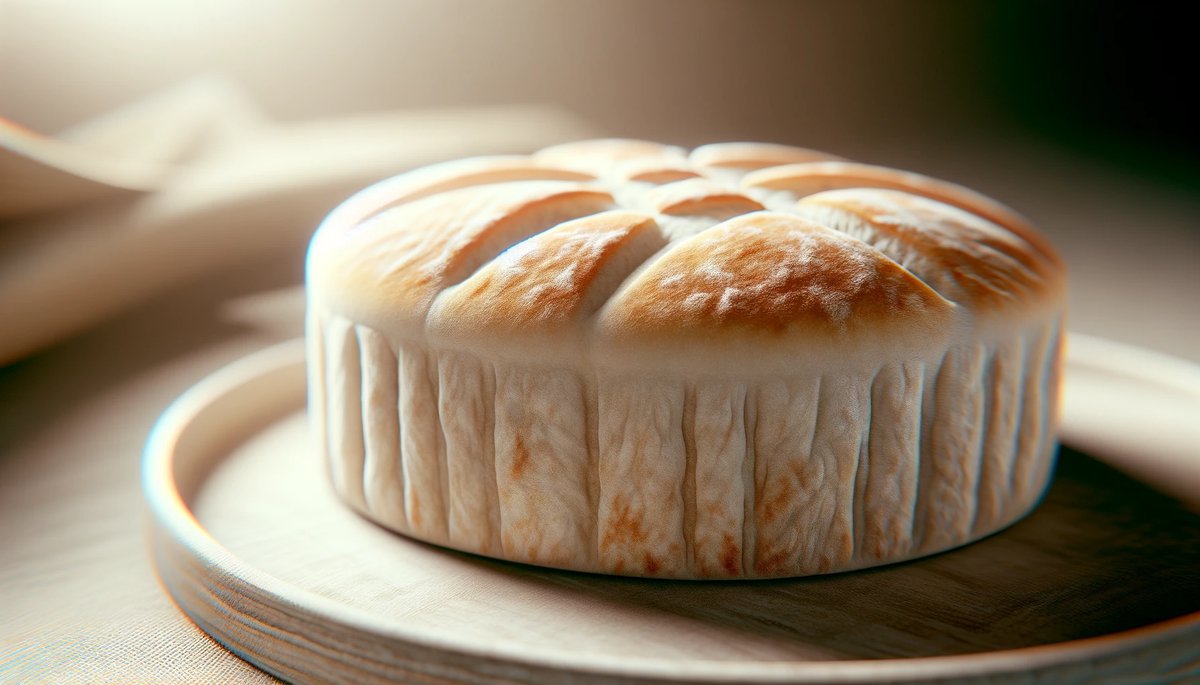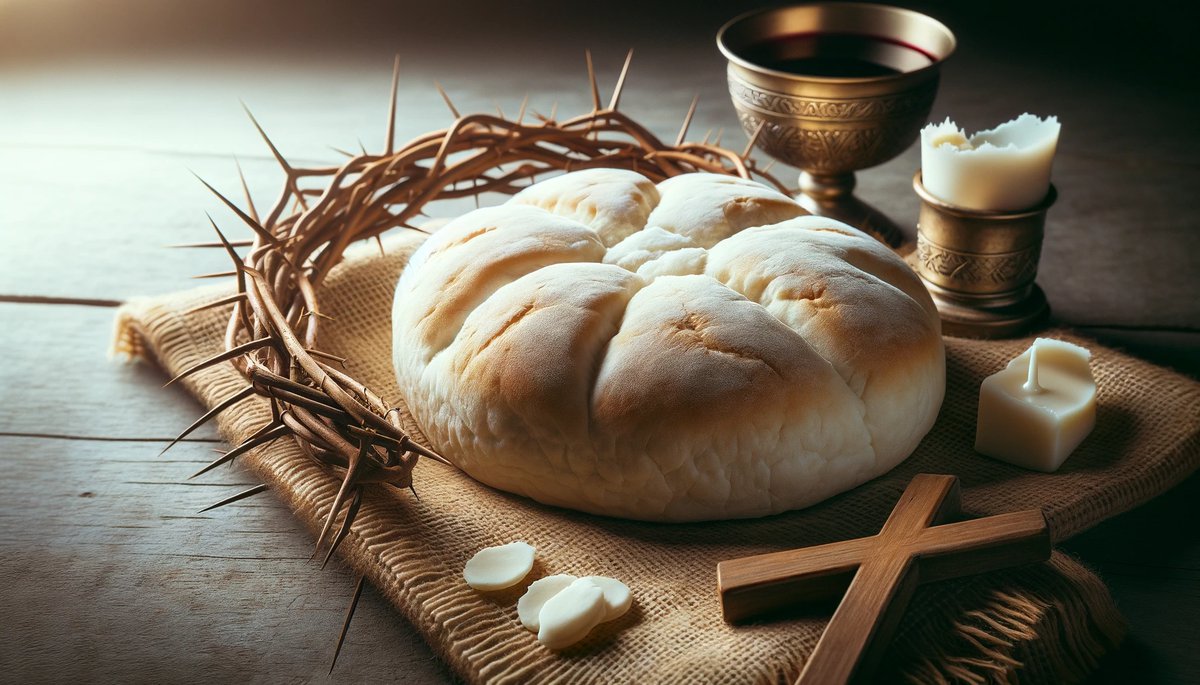Home>Theology and Spirituality>How To Make Bread For Communion


Theology and Spirituality
How To Make Bread For Communion
Published: February 24, 2024
Ericka Andersen, an editor at Christian.net, expertly merges digital strategy with content creation, focusing on faith and societal issues. Her communication skills enhance the platform's engaging narratives, fostering meaningful dialogue on belief's impact on society.
Learn the sacred art of making bread for communion with our comprehensive guide. Explore the theological significance and spiritual practices involved. Ideal for those interested in theology and spirituality.
(Many of the links in this article redirect to a specific reviewed product. Your purchase of these products through affiliate links helps to generate commission for Christian.net, at no extra cost. Learn more)
Table of Contents
Introduction
The act of sharing bread and wine as part of a sacred ritual has been a cornerstone of religious practice for centuries. In Christian tradition, the consumption of bread and wine during the Eucharist, also known as communion, holds profound spiritual significance. The communion bread, in particular, symbolizes the body of Christ and serves as a focal point for believers to come together in remembrance and reverence.
The process of making communion bread is steeped in tradition and carries deep spiritual meaning. It involves careful preparation and a profound sense of reverence for the sacred act it represents. Whether it is a small, intimate gathering or a larger congregation, the communion bread plays a central role in the shared experience of faith and community.
In this article, we will delve into the art of making communion bread, exploring its significance, the ingredients required, step-by-step instructions for preparation, and tips for ensuring that the bread is suitable for communion use. By understanding the spiritual and practical aspects of this time-honored tradition, individuals can approach the process with a deeper sense of purpose and reverence.
The act of making communion bread is not merely a culinary endeavor; it is a sacred practice that connects individuals to their faith and to one another. As we embark on this journey of discovery, we will uncover the rich symbolism and spiritual depth inherent in the simple act of preparing the bread for communion. Through this exploration, we can gain a deeper appreciation for the profound significance of communion and the role that the bread plays in uniting believers in a shared expression of faith and devotion.
Read more: How To Bake Holy Communion Bread
Understanding the significance of communion bread
The communion bread, also known as the Eucharistic bread or the sacramental bread, holds a deeply symbolic and spiritual significance within the Christian faith. It is an integral part of the Eucharist, a sacred ritual that commemorates the Last Supper, where Jesus shared bread and wine with his disciples. The act of consuming the bread and wine during the Eucharist is believed to symbolize the body and blood of Christ, and it serves as a profound expression of faith, unity, and remembrance.
The communion bread represents the body of Christ, broken and shared among believers as a tangible reminder of Jesus' sacrifice on the cross. It embodies the concept of spiritual nourishment and sustenance, signifying the spiritual union between Christ and his followers. The act of partaking in the communion bread is a solemn and reverent practice, inviting individuals to reflect on the teachings of Christ, seek forgiveness, and renew their commitment to living a life guided by faith and love.
Beyond its symbolic representation, the communion bread fosters a sense of community and fellowship among believers. As individuals come together to partake in the Eucharist, the sharing of the bread signifies a shared bond and unity in faith. It transcends individual experiences and unites the faithful in a collective expression of devotion and spiritual communion.
The significance of communion bread extends beyond the confines of the physical act of consumption. It serves as a powerful symbol of reconciliation, forgiveness, and the promise of eternal life. Through the act of partaking in the bread, believers reaffirm their connection to the teachings of Christ and embrace the hope and redemption offered through his sacrifice.
In essence, the communion bread embodies the core tenets of Christian faith, encapsulating the themes of sacrifice, unity, remembrance, and spiritual nourishment. It stands as a timeless symbol of the enduring presence of Christ within the hearts of believers and the unifying force that binds the faithful in a shared journey of faith and devotion.
Ingredients needed for making communion bread
-
High-quality flour: The foundation of communion bread, high-quality flour serves as the primary ingredient, symbolizing purity and sustenance. Opt for finely milled, unbleached flour to ensure a smooth texture and consistent baking results.
-
Water: Pure, clean water is essential for binding the flour and forming the dough. The simplicity of water underscores the humble nature of the communion bread, emphasizing its role as a unifying element in the sacred ritual.
-
Olive oil: Adding a touch of olive oil to the communion bread not only enhances its flavor but also carries symbolic significance. Olive oil, often associated with spiritual anointing and healing, infuses the bread with a sense of divine blessing and nourishment.
-
Salt: A small amount of salt is used to season the communion bread, symbolizing the preservation of faith and the enduring nature of spiritual teachings. It serves as a reminder of the essential role of faith in preserving the unity and strength of the community of believers.
-
Honey: In some traditions, a hint of honey is incorporated into the communion bread, representing the sweetness of spiritual nourishment and the enduring presence of God's grace. The addition of honey infuses the bread with a subtle sweetness, symbolizing the richness of spiritual sustenance.
-
Yeast: For leavened communion bread, yeast is used to facilitate the rising of the dough, symbolizing growth, transformation, and the renewal of faith. The process of fermentation mirrors the spiritual journey of believers, emphasizing the transformative power of faith and the continuous renewal of the soul.
-
Unleavened bread: In traditions that call for unleavened communion bread, the absence of yeast symbolizes purity, simplicity, and the absence of worldly influences. Unleavened bread serves as a powerful symbol of the unadorned, pure body of Christ, emphasizing the essential nature of spiritual purity and devotion.
-
Communion vessels: While not an ingredient in the traditional sense, the vessels used to prepare and serve the communion bread hold profound symbolic significance. Chalices, patens, and other sacred vessels are used to honor and contain the bread, underscoring its sacred nature and the reverence with which it is handled.
The careful selection and thoughtful preparation of these ingredients are essential in creating communion bread that embodies the spiritual significance and symbolic richness of this sacred tradition. Each element contributes to the profound symbolism and deep spiritual meaning inherent in the communion bread, underscoring its role as a central symbol of faith, unity, and spiritual nourishment.
Step-by-step instructions for making communion bread
-
Gathering the Ingredients: Begin by gathering the essential ingredients for making the communion bread. Ensure that the flour, water, olive oil, salt, and any additional components such as honey or yeast are readily available. This initial step sets the stage for the reverent and purposeful process of creating the sacred bread.
-
Preparing the Work Surface: Clear and clean a designated work surface, signifying the sanctity of the task at hand. This space serves as the sacred canvas upon which the communion bread will be crafted, underscoring the solemnity and reverence of the preparation process.
-
Mixing the Ingredients: In a large mixing bowl, combine the flour, water, olive oil, salt, and any additional ingredients according to the chosen recipe or tradition. As the ingredients come together, the act of mixing symbolizes the unity and harmony of the faith community, reflecting the coming together of individuals in shared devotion and spiritual communion.
-
Kneading the Dough: Once the ingredients are combined, knead the dough with purpose and intention. The rhythmic motion of kneading embodies the dedication and care invested in the preparation of the communion bread, emphasizing the spiritual significance of the process.
-
Shaping the Bread: With reverence and mindfulness, shape the dough into the desired form, whether it be round loaves, wafers, or any other traditional shape. Each motion carries profound symbolism, reflecting the shaping and molding of the faith community through shared spiritual experiences and devotion.
-
Baking the Bread: Place the shaped dough onto a baking sheet or into a suitable baking vessel, and allow it to bake until it achieves the desired texture and color. The act of baking signifies the transformative process of spiritual growth and renewal, mirroring the profound changes experienced through faith and devotion.
-
Prayerful Reflection: As the communion bread bakes, take a moment for prayerful reflection, contemplating the spiritual significance of the bread and its role in fostering unity, remembrance, and nourishment within the faith community. This moment of reflection deepens the connection to the sacred act of communion and infuses the bread with profound spiritual meaning.
-
Honoring the Bread: Once the communion bread is baked and cooled, handle it with utmost care and reverence. Place it in the designated communion vessels, such as patens or other sacred receptacles, honoring the bread as a symbol of the body of Christ and the spiritual nourishment it represents.
-
Blessing the Bread: In accordance with individual traditions, the communion bread may be blessed by a clergy member or designated spiritual leader, invoking divine grace and sanctification upon the bread. This act of blessing imbues the bread with sacred significance, affirming its role as a conduit of spiritual nourishment and unity within the faith community.
-
Communal Sharing: The communion bread is now ready to be shared within the faith community during the sacred ritual of the Eucharist. As it is distributed among the faithful, the communion bread serves as a tangible expression of unity, remembrance, and spiritual sustenance, fostering a shared experience of faith and devotion.
By following these step-by-step instructions with reverence and intention, individuals can partake in the sacred act of preparing communion bread, infusing the process with deep spiritual significance and honoring the timeless tradition of the Eucharist.
Tips for ensuring the bread is suitable for communion use
-
Attention to Ingredients: Select high-quality, unadulterated ingredients for the communion bread. Opt for pure, unbleached flour, clean water, and authentic olive oil to maintain the integrity and symbolism of the bread as a representation of purity and spiritual nourishment.
-
Mindful Preparation: Approach the process of making communion bread with a spirit of reverence and mindfulness. Infuse each step with intention and purpose, recognizing the sacred nature of the bread and its role in fostering spiritual unity and remembrance.
-
Symbolic Significance: Reflect on the symbolic significance of each ingredient and step in the bread-making process. Consider the profound spiritual meanings associated with flour, water, oil, and other components, and ensure that each element aligns with the intended symbolism of the communion bread.
-
Adherence to Tradition: Respect and honor the traditions and practices associated with communion bread within your specific faith community. Whether it involves leavened or unleavened bread, traditional shapes, or specific blessings, adhere to the established customs to maintain the authenticity and spiritual resonance of the bread.
-
Prayerful Intentions: Infuse the entire bread-making process with prayerful intentions and spiritual contemplation. Offer prayers or meditations as you gather the ingredients, mix the dough, and shape the bread, inviting divine presence and sanctification into the sacred act of bread preparation.
-
Sanctity of Preparation Space: Designate a clean and consecrated space for the preparation of the communion bread. Ensure that the work surface and utensils are meticulously clean, signifying the sanctity and reverence with which the bread is crafted for use in the sacred ritual.
-
Unity and Inclusivity: Embrace the spirit of unity and inclusivity in the bread-making process. Consider involving members of the faith community in the preparation, fostering a sense of shared responsibility and participation in the sacred act of creating communion bread.
-
Attention to Detail: Pay close attention to the details of the bread-making process, from the consistency of the dough to the shaping and baking of the bread. Each aspect contributes to the overall symbolism and suitability of the bread for use in the Eucharist, underscoring the importance of precision and care.
-
Solemn Blessing: Seek a solemn blessing for the communion bread, either through personal prayers or by involving a clergy member or spiritual leader. The act of blessing the bread imbues it with divine grace and sanctification, affirming its suitability for use in the sacred ritual of communion.
-
Spiritual Reflection: Take moments for spiritual reflection and contemplation throughout the bread-making process. Consider the profound significance of the communion bread as a symbol of unity, nourishment, and remembrance, allowing these reflections to infuse the bread with deep spiritual resonance.
By embracing these tips and approaches, individuals can ensure that the communion bread is prepared with utmost reverence, authenticity, and spiritual significance, making it truly suitable for use in the sacred ritual of communion.
Conclusion
In conclusion, the art of making communion bread transcends the realm of culinary craftsmanship, embodying profound spiritual significance and symbolic richness. The communion bread, as a central element of the Eucharist, serves as a tangible representation of the body of Christ and the spiritual nourishment offered to believers. Through the careful selection of ingredients, purposeful preparation, and mindful reflection, individuals can partake in the sacred act of creating communion bread with a deep sense of reverence and devotion.
The significance of the communion bread extends far beyond its physical form. It encapsulates the core tenets of Christian faith, symbolizing unity, remembrance, and the enduring presence of Christ within the faith community. Each ingredient and step in the bread-making process carries profound symbolism, reflecting the spiritual nourishment, purity, and transformative power inherent in the act of communion.
By understanding the spiritual and symbolic significance of the communion bread, individuals can approach its preparation with a heightened sense of purpose and reverence. The act of making communion bread becomes a sacred ritual in itself, fostering a deeper connection to the traditions and teachings of the faith. It serves as a unifying force, bringing together individuals in a shared expression of devotion and spiritual communion.
As the communion bread is prepared with meticulous care and spiritual intention, it becomes a conduit for unity, remembrance, and the embodiment of Christ's teachings. The act of sharing the bread during the Eucharist fosters a profound sense of community and fellowship, transcending individual experiences and uniting believers in a collective expression of faith and devotion.
In essence, the communion bread stands as a timeless symbol of the enduring presence of Christ within the hearts of believers and the unifying force that binds the faithful in a shared journey of faith and devotion. Through the art of making communion bread, individuals can partake in a sacred tradition that honors the teachings of Christ, fosters spiritual unity, and reaffirms the profound significance of communion in the Christian faith.














